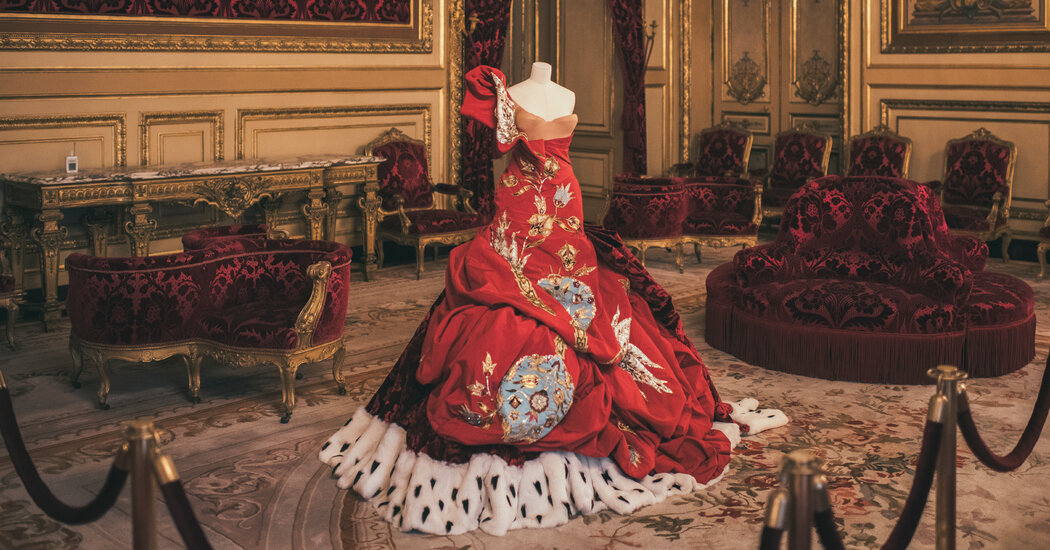Ornamental hours from the sixteenth century frame a metal bodysuit from Thierry Mugler. Gilded silver reliquaries with carved hands stand next to a pair of Hermès gloves. A ceramic hand warmer from Faenza, Italy, who looks like a book, is combined with a Chanel clutch that looks like a book.
This is ‘Louvre Couture’, the first fashion exhibition in the famous Paris museum in his 231-year-old history.
The last time that Haute Couture caused so much excitement in the Louvre was in 1957, when Audrey Hepburn posed in the film Funny Face for the Winged Victory of Samothrace in a strapless red dress from Givenchy and the Daru stage ran off. Lift a matching chiffon scarf over her head.
Forty -five fashion houses and designers – from Cristóbal Balenciaga to Iris van Herpen – have lent the Museum 100 ensembles and accessories, dating from 1960 to 2025. They are not between the famous paintings and marble sculptures of the Louvre, but spread over the nearly 100,000 Square meter large exhibition space. From the Decorative Arts department.
The department, the extensive collection of the Middle Ages to the beginning of the 19th century, is crammed with thousands of objects: medieval arms, tapestries from the Renaissance, sculpted ivory, bronze, ceramic, imperial silverware and furniture.
“It is not easy to enter our museum, and certainly not our collection,” says Olivier Gabet, director of the Decorative Arts department. “Our goal is to make more people, different people, younger people, happy, free and relaxed when they come here. We say to them: ‘Okay, you like fashion. Fashion is a bridge for us. “”
With this exhibition, which starts on January 24, the Louvre joins the ranks of institutions that have discovered how they can use the popular clothing culture as a gateway to the world of art. And more than ever, fashion seduces French museums and artistic spaces.
Two weeks before the Louvre opened its exhibition on January 24, Dolce & Gabbana opened its own fashion spectacle: ‘From the Heart to the Hands’, in the recently renovated Grand Palais. The traveling costume ritisse was opened for the first time in Milan last spring and shows more than 200 creations from the house in compelling video installations and extensive decors.
But this is not a museum exhibition. “This is an experience that is especially joyful,” says Florence Müller, creative director of the exhibition. “It is intellectual in the second place. It is not intended that it is in a museum. “
Next month, the Musée du Quai Branly, a collection of African, Oceanic, American and Asian works, ‘Golden Thread’, will open an exhibition aimed at the art of using gold to decorate clothing and jewelry. In May, in the Petit Palais, which belongs to the city of Paris, ‘Worth: The Birth of Haute Couture’ will be exhibited, a retrospective about the life and work of the British designer Charles Frederick Worth (1825-1895).
Two modemusea, one with collections of the state (the Musée des Arts Décoratifs), the other of the city (Palais Galliera), have long offer beautiful permanent collections and temporary exhibitions. More recently, luxury groups such as LVMH and Kering have opened their own art exhibition spaces. And Saint Laurent, Dior and Alaïa have all created permanent spaces to show their work.
“Museums and fashion have been dancing together for decades,” says Pamela Golbin, former head curator Fashion and Textiles of the Musée des Arts Décoratifs. “Now there is real rapprochement. It is not always a successful combination, but if it arouses the interest of the audience – if it can see the art differently – it is a great way to use the power of fashion. ”
The determining example of this approach is of course the Metropolitan Museum of Art in New York, where the Blockbusters shows of the Costume Institute are among the most visited of the museum every year. As a recognition of the capacity of fashion to attract visitors, it is in the middle of a renovation where the fashion department will move from the basement, where it was historically located, to the former gift shop in the Great Hall, the majestic main entrance.
The Louvre, with 8.7 million visitors in 2024, does not need fashion to increase the number of visitors. On the contrary, it has limited its daily visitor numbers to 30,000 to reduce the overcrowding. Only 23 percent of visitors to the Louvre are French; The rest are foreigners. And 66 percent of the visitors exists for the first time, and almost all of them stand in line to see the Mona Lisa.
Since Laurence des Cars became director of the museum in 2021, she has trouble luring returning visitors, a younger audience and more Parisians to the Louvre. She opened the museum on some evenings, organized concerts and theater performances and experimented with a dance and moving circuit. The new fashion fair fits seamlessly into this strategy.
Mrs. des Cars even expresses so much admiration for the initiatives of the Met that some of her trustees complain that she has been obsessed with.
It is no coincidence that the Louvre – perhaps in a weak echo of Gala – combines the new fashion exhibition with a fundraising gala, Le Grand Dîner du Louvre, during the Paris Fashion Week in March. The dinner is served between the marble sculptures in the Cour Marly with glass roof and is followed by dancing under the pyramid. More than thirty tables were offered for sale and the collection goal of a million euros has already been exceeded, according to the museum.
This exhibition is the logical next step for the Louvre, which has already entered the fashion world on its toes. In 2022 it was one of the six prestigious French museums that commemorated the 60th birthday of the Saint Laurent house by exhibiting 50 of his creations in their permanent collections. The Louvre placed four of his embroidered and jewelry -occupied jackets next to the French crown jewels in the gilt apollog gallery.
Currently, the Kleine Musée National Eugène-Delacroix, which belongs to the Louvre, has an exhibition called ‘States of (un) Dress: Delacroix and Clothing’, in which it is investigated how carefully the artist has chosen the clothing in his paintings. And in March Louvre-Lens, the satellite museum of the Louvre in Northern France, an exhibition called ‘The Art of Dressing: dressing like an artist’, in which it is investigated which artists chose to wear and why, from the Renaissance to now.
“Art historians often have to know the history of clothing to know the history of art,” says Bruno Racine, the former head of the National Library of France and now head of the Palazzo Grassi in Venice, which belongs to the French billionaire François Pinault . Founder of the Kering Luxegroep. “This is nothing artificial.”
The Louvre can never match when it comes to fashion. In contrast to it, the Louvre is not a private museum, but a hierarchical institution -run with a limited budget, which receives its orders from the Ministry of Culture and ultimately from the French president.
In a confidential memo to Minister of Culture Rachida Dati earlier this month, Mrs. des Cars, the disastrous physical state of the museum,, including water leaks and temperature fluctuations, condemned artworks, overcrowding, insufficient toilet facilities and poor signage.
Even the showpiece of the glass pyramid, designed by IM Pei and inaugurated in 1989, was “very inhospitable,” said the memo, which was published in the newspaper Le Parisien on Thursday.
But for the time being, the decorative art department of the Louvre has at least one of the best sets for showing fashion: the apartments of Keizer Napoleon III. The 12 meter high Salon theater exudes a beautiful abundance with crystal chandeliers, a ceiling full of frescoes and stucco decorations with gold leaf, vases with flowers and angels that play instruments.
In the middle of the salon is a mannequin with an embroidered ball dress from red silk and cut velvet with a deep ermine hem, designed by John Galliano for Christian Dior. The dress fits perfectly with the red -cut velvet upholstery and curtains of the salon. She immediately looks at home.
Elaine Sciolino, writer for The New York Times in Paris, is the author of ‘Adventures in The Louvre: How to Fall in Love With The World’s Greatest Museum’, which will appear in April 2025.





